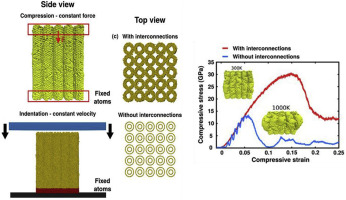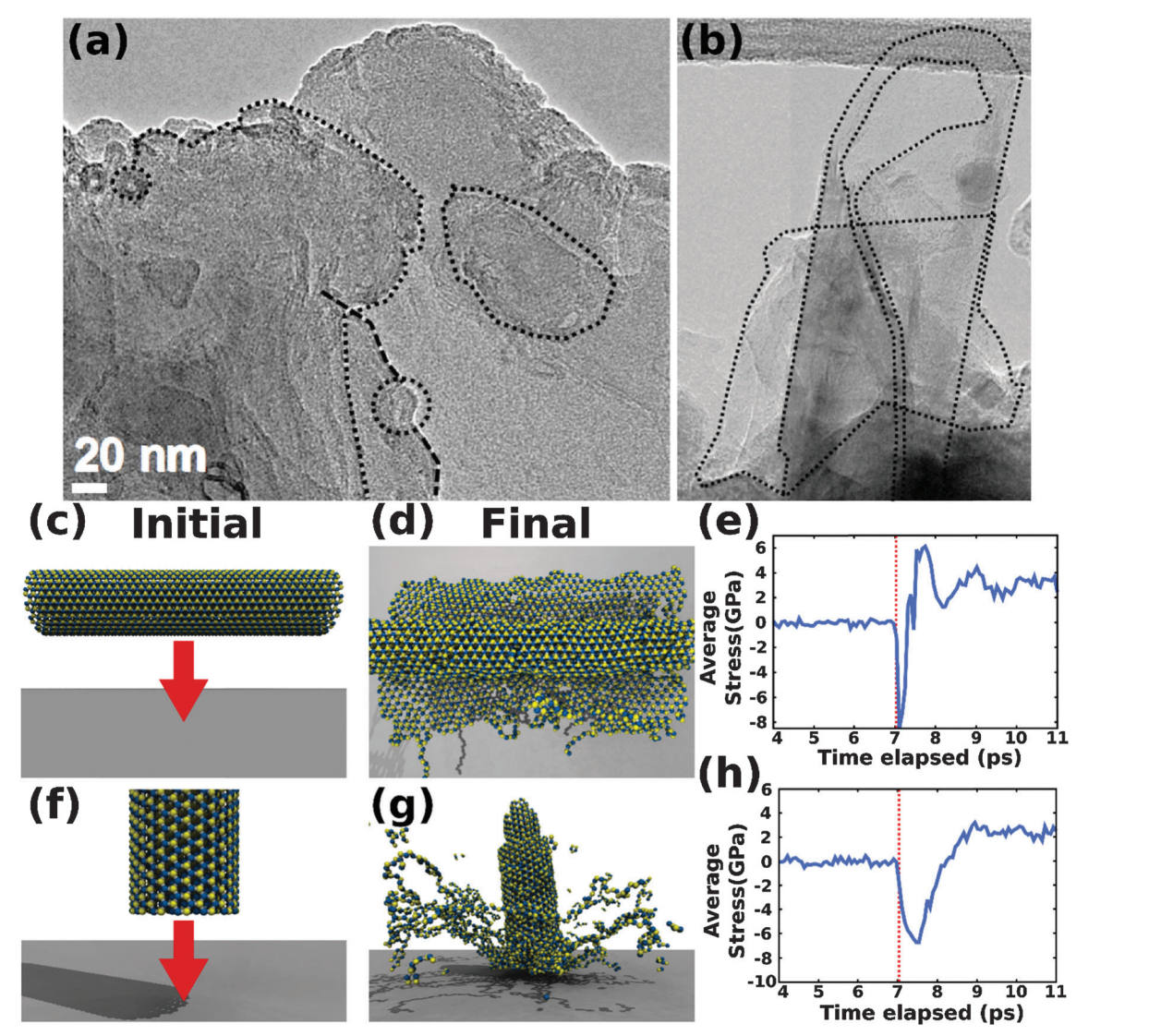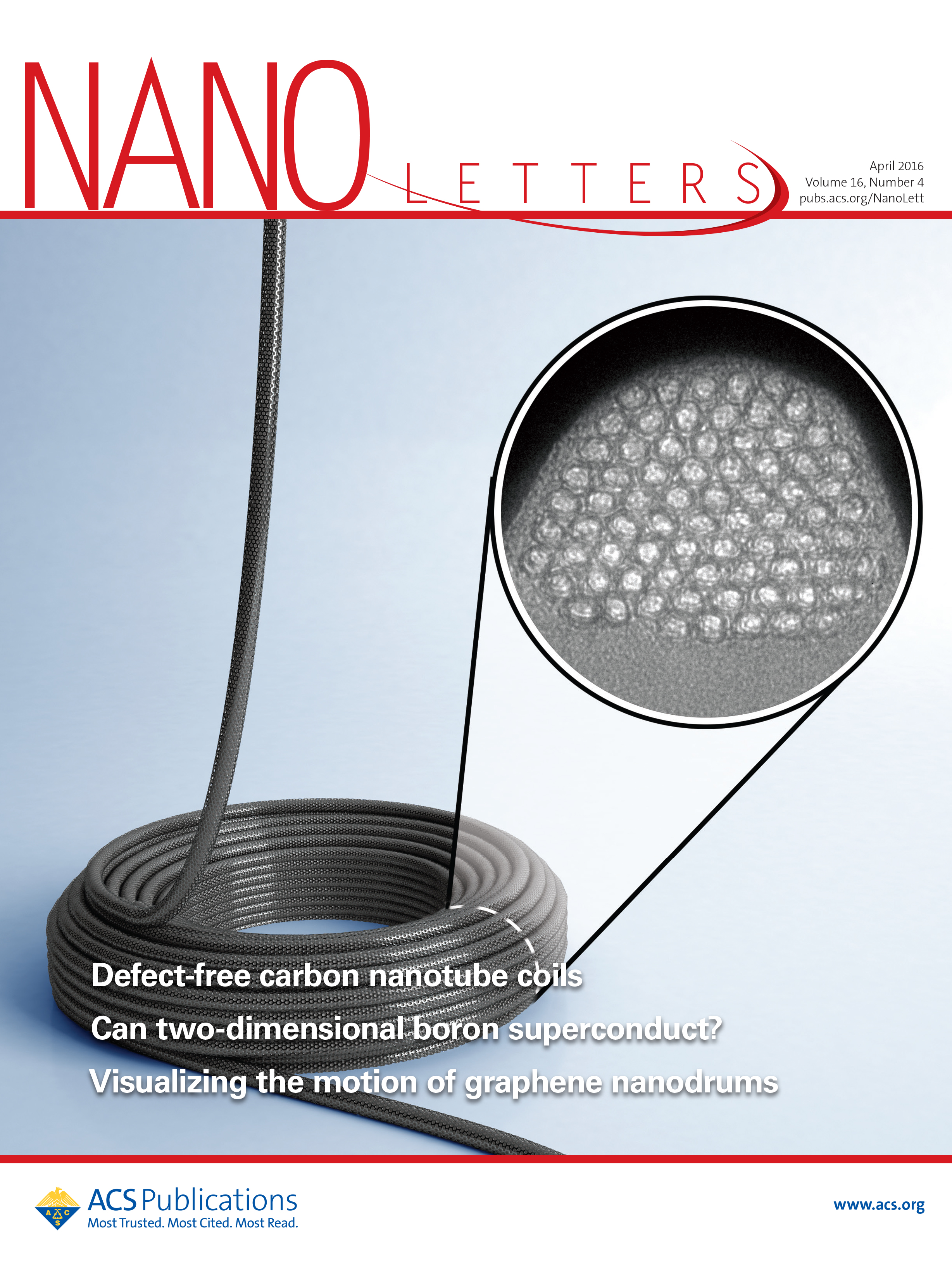Sanjit; Ozden Bhowmick, Sehmus; Bizão
High temperature quasistatic and dynamic mechanical behavior of interconnected 3D carbon nanotube structures Journal Article
In: Carbon, vol. 142, pp. 291-299, 2019.
@article{Bhowmick2019,
title = {High temperature quasistatic and dynamic mechanical behavior of interconnected 3D carbon nanotube structures},
author = {Bhowmick, Sanjit; Ozden, Sehmus; Bizão, Rafael A; Machado, Leonardo Dantas; Asif, SA Syed; Pugno, Nicola M; Galvao, Douglas S; Tiwary, Chandra Sekhar; Ajayan, PM},
url = {https://www.sciencedirect.com/science/article/pii/S0008622318308911},
doi = {10.1016/j.carbon.2018.09.075},
year = {2019},
date = {2019-02-01},
journal = {Carbon},
volume = {142},
pages = {291-299},
abstract = {Carbon nanotubes (CNTs) are one of the most appealing materials in recent history for both research and commercial interest because of their outstanding physical, chemical, and electrical properties. This is particularly true for 3D arrangements of CNTs which enable their use in larger scale devices and structures. In this paper, the effect of temperature on the quasistatic and dynamic deformation behavior of 3D CNT structures is presented for the first time. An in situ high-temperature nanomechanical instrument was used inside an SEM at high vacuum to investigate mechanical properties of covalently interconnected CNT porous structures in a wide range of temperature. An irreversible bucking at the base of pillar samples was found as a major mode of deformation at room and elevated temperatures. It has been observed that elastic modulus and critical load to first buckle formation decrease progressively with increasing temperature from 25 °C to 750 °C. To understand fatigue resistance, pillars made from this unique structure were compressed to 100 cycles at room temperature and 750 °C. While the structure showed remarkable resistance to fatigue at room temperature, high temperature significantly lowers fatigue resistance. Molecular dynamics (MD) simulation of compression highlights the critical role played by covalent interconnections which prevent localized bending and improve mechanical properties.},
keywords = {},
pubstate = {published},
tppubtype = {article}
}
Sehmus Ozden Leonardo D Machado, ChandraSekhar Tiwary
The structural and dynamical aspects of boron nitride nanotubes under high velocity impacts Journal Article
In: Physical Chemistry Chemical Physics, vol. 18, pp. 14776-14781, 2016.
@article{Machado2016,
title = {The structural and dynamical aspects of boron nitride nanotubes under high velocity impacts},
author = {Leonardo D Machado, Sehmus Ozden, ChandraSekhar Tiwary, Pedro AS Autreto, Robert Vajtai, Enrique V Barrera, Douglas S Galvao, Pulickel M Ajayan},
url = {xlink.rsc.org/?DOI=c6cp01949h},
doi = {10.1039/C6CP01949H},
year = {2016},
date = {2016-05-01},
journal = {Physical Chemistry Chemical Physics},
volume = {18},
pages = {14776-14781},
abstract = {This communication report is a study on the structural and dynamical aspects of boron nitride nanotubes (BNNTs) shot at high velocities (∼5 km s−1) against solid targets. The experimental results show unzipping of BNNTs and the formation of hBN nanoribbons. Fully atomistic reactive molecular dynamics simulations were also carried out to gain insights into the BNNT fracture patterns and deformation mechanisms. Our results show that longitudinal and axial tube fractures occur, but the formation of BN nanoribbons from fractured tubes was only observed for some impact angles. Although some structural and dynamical features of the impacts are similar to the ones reported for CNTs, because BNNTs are more brittle than CNTs this results in a larger number of fractured tubes but with fewer formed nanoribbons.},
keywords = {},
pubstate = {published},
tppubtype = {article}
}
Anna Kremen Nitzan Shadmi, Yiftach Frenkel; Joselevich, Ernesto
Defect-Free Carbon Nanotube Coils Journal Article
In: Nano Letters, vol. 16, no. 4, pp. 2152–2158, 2016.
@article{Shadmi2016,
title = {Defect-Free Carbon Nanotube Coils},
author = {Nitzan Shadmi, Anna Kremen, Yiftach Frenkel, Zachary J. Lapin, Leonardo D. Machado, Sergio B. Legoas, Ora Bitton, Katya Rechav, Ronit Popovitz-Biro, Douglas S. Galvão, Ado Jorio, Lukas Novotny, Beena Kalisky, and Ernesto Joselevich},
url = {http://pubs.acs.org/doi/abs/10.1021/acs.nanolett.5b03417},
doi = {10.1021/acs.nanolett.5b03417},
year = {2016},
date = {2016-04-01},
journal = {Nano Letters},
volume = {16},
number = {4},
pages = {2152–2158},
abstract = {Carbon nanotubes are promising building blocks for various nanoelectronic components. A highly desirable geometry for such applications is a coil. However, coiled nanotube structures reported so far were inherently defective or had no free ends accessible for contacting. Here we demonstrate the spontaneous self-coiling of single-wall carbon nanotubes into defect-free coils of up to more than 70 turns with identical diameter and chirality, and free ends. We characterize the structure, formation mechanism, and electrical properties of these coils by different microscopies, molecular dynamics simulations, Raman spectroscopy, and electrical and magnetic measurements. The coils are highly conductive, as expected for defect-free carbon nanotubes, but adjacent nanotube segments in the coil are more highly coupled than in regular bundles of single-wall carbon nanotubes, owing to their perfect crystal momentum matching, which enables tunneling between the turns. Although this behavior does not yet enable the performance of these nanotube coils as inductive devices, it does point a clear path for their realization. Hence, this study represents a major step toward the production of many different nanotube coil devices, including inductors, electromagnets, transformers, and dynamos.},
keywords = {},
pubstate = {published},
tppubtype = {article}
}
2019

Sanjit; Ozden Bhowmick, Sehmus; Bizão
High temperature quasistatic and dynamic mechanical behavior of interconnected 3D carbon nanotube structures Journal Article
In: Carbon, vol. 142, pp. 291-299, 2019.
Abstract | Links | BibTeX | Tags: CNT, Fracture, Mechanical Properties, Molecular Dynamics
@article{Bhowmick2019,
title = {High temperature quasistatic and dynamic mechanical behavior of interconnected 3D carbon nanotube structures},
author = {Bhowmick, Sanjit; Ozden, Sehmus; Bizão, Rafael A; Machado, Leonardo Dantas; Asif, SA Syed; Pugno, Nicola M; Galvao, Douglas S; Tiwary, Chandra Sekhar; Ajayan, PM},
url = {https://www.sciencedirect.com/science/article/pii/S0008622318308911},
doi = {10.1016/j.carbon.2018.09.075},
year = {2019},
date = {2019-02-01},
journal = {Carbon},
volume = {142},
pages = {291-299},
abstract = {Carbon nanotubes (CNTs) are one of the most appealing materials in recent history for both research and commercial interest because of their outstanding physical, chemical, and electrical properties. This is particularly true for 3D arrangements of CNTs which enable their use in larger scale devices and structures. In this paper, the effect of temperature on the quasistatic and dynamic deformation behavior of 3D CNT structures is presented for the first time. An in situ high-temperature nanomechanical instrument was used inside an SEM at high vacuum to investigate mechanical properties of covalently interconnected CNT porous structures in a wide range of temperature. An irreversible bucking at the base of pillar samples was found as a major mode of deformation at room and elevated temperatures. It has been observed that elastic modulus and critical load to first buckle formation decrease progressively with increasing temperature from 25 °C to 750 °C. To understand fatigue resistance, pillars made from this unique structure were compressed to 100 cycles at room temperature and 750 °C. While the structure showed remarkable resistance to fatigue at room temperature, high temperature significantly lowers fatigue resistance. Molecular dynamics (MD) simulation of compression highlights the critical role played by covalent interconnections which prevent localized bending and improve mechanical properties.},
keywords = {CNT, Fracture, Mechanical Properties, Molecular Dynamics},
pubstate = {published},
tppubtype = {article}
}
2016

Sehmus Ozden Leonardo D Machado, ChandraSekhar Tiwary
The structural and dynamical aspects of boron nitride nanotubes under high velocity impacts Journal Article
In: Physical Chemistry Chemical Physics, vol. 18, pp. 14776-14781, 2016.
Abstract | Links | BibTeX | Tags: Ballistic Impact, Boron Nitride tubes, CNT, Fracture, Molecular Dynamics
@article{Machado2016,
title = {The structural and dynamical aspects of boron nitride nanotubes under high velocity impacts},
author = {Leonardo D Machado, Sehmus Ozden, ChandraSekhar Tiwary, Pedro AS Autreto, Robert Vajtai, Enrique V Barrera, Douglas S Galvao, Pulickel M Ajayan},
url = {xlink.rsc.org/?DOI=c6cp01949h},
doi = {10.1039/C6CP01949H},
year = {2016},
date = {2016-05-01},
journal = {Physical Chemistry Chemical Physics},
volume = {18},
pages = {14776-14781},
abstract = {This communication report is a study on the structural and dynamical aspects of boron nitride nanotubes (BNNTs) shot at high velocities (∼5 km s−1) against solid targets. The experimental results show unzipping of BNNTs and the formation of hBN nanoribbons. Fully atomistic reactive molecular dynamics simulations were also carried out to gain insights into the BNNT fracture patterns and deformation mechanisms. Our results show that longitudinal and axial tube fractures occur, but the formation of BN nanoribbons from fractured tubes was only observed for some impact angles. Although some structural and dynamical features of the impacts are similar to the ones reported for CNTs, because BNNTs are more brittle than CNTs this results in a larger number of fractured tubes but with fewer formed nanoribbons.},
keywords = {Ballistic Impact, Boron Nitride tubes, CNT, Fracture, Molecular Dynamics},
pubstate = {published},
tppubtype = {article}
}

Anna Kremen Nitzan Shadmi, Yiftach Frenkel; Joselevich, Ernesto
Defect-Free Carbon Nanotube Coils Journal Article
In: Nano Letters, vol. 16, no. 4, pp. 2152–2158, 2016.
Abstract | Links | BibTeX | Tags: CNT, Coils, Molecular Dynamics, Synthesis, TEM
@article{Shadmi2016,
title = {Defect-Free Carbon Nanotube Coils},
author = {Nitzan Shadmi, Anna Kremen, Yiftach Frenkel, Zachary J. Lapin, Leonardo D. Machado, Sergio B. Legoas, Ora Bitton, Katya Rechav, Ronit Popovitz-Biro, Douglas S. Galvão, Ado Jorio, Lukas Novotny, Beena Kalisky, and Ernesto Joselevich},
url = {http://pubs.acs.org/doi/abs/10.1021/acs.nanolett.5b03417},
doi = {10.1021/acs.nanolett.5b03417},
year = {2016},
date = {2016-04-01},
journal = {Nano Letters},
volume = {16},
number = {4},
pages = {2152–2158},
abstract = {Carbon nanotubes are promising building blocks for various nanoelectronic components. A highly desirable geometry for such applications is a coil. However, coiled nanotube structures reported so far were inherently defective or had no free ends accessible for contacting. Here we demonstrate the spontaneous self-coiling of single-wall carbon nanotubes into defect-free coils of up to more than 70 turns with identical diameter and chirality, and free ends. We characterize the structure, formation mechanism, and electrical properties of these coils by different microscopies, molecular dynamics simulations, Raman spectroscopy, and electrical and magnetic measurements. The coils are highly conductive, as expected for defect-free carbon nanotubes, but adjacent nanotube segments in the coil are more highly coupled than in regular bundles of single-wall carbon nanotubes, owing to their perfect crystal momentum matching, which enables tunneling between the turns. Although this behavior does not yet enable the performance of these nanotube coils as inductive devices, it does point a clear path for their realization. Hence, this study represents a major step toward the production of many different nanotube coil devices, including inductors, electromagnets, transformers, and dynamos.},
keywords = {CNT, Coils, Molecular Dynamics, Synthesis, TEM},
pubstate = {published},
tppubtype = {article}
}
http://scholar.google.com/citations?hl=en&user=95SvbM8AAAAJ


